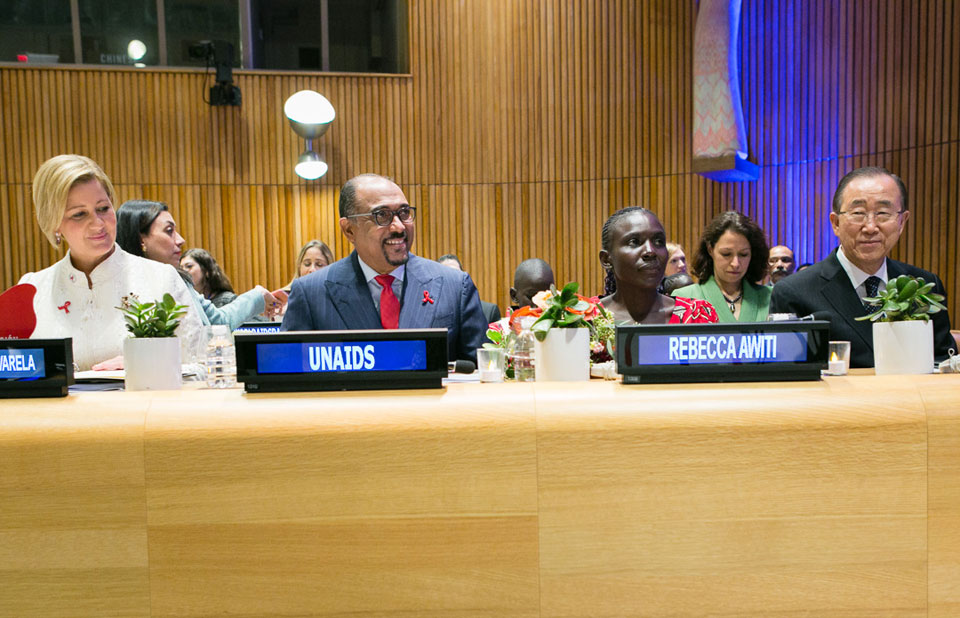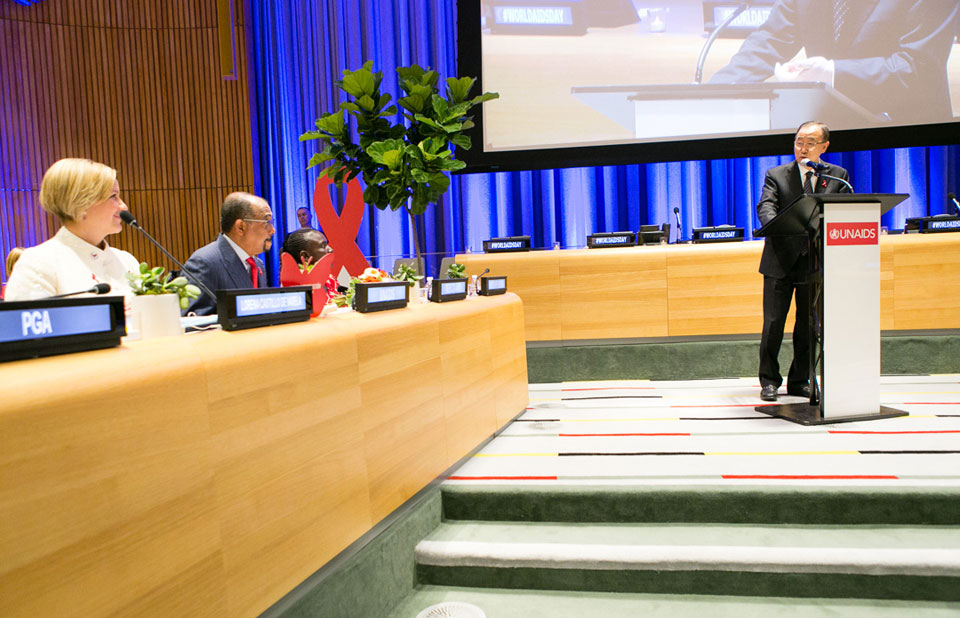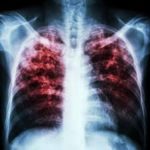Eighteen million people are on HIV treatment across the world, the Joint United Nations Programme on HIV/Aids (UNAIDS) has said.
Speaking on the eve of the World Aids Day, the UNAIDS Executive Director Michel Sidibe also paid tribute to the Secretary-General and the exceptional achievements made in the AIDS response during his tenure.
Following a moment’s silence to remember the 35 million people who have lost their lives to AIDS, Dr Sidibe presented Mr Ban with the UNAIDS Award for Leadership for speaking out on behalf of, and his commitment to, the people most affected by HIV.
“Secretary-General Ban Ki-moon, you have been a true champion for people living with HIV. When you arrived only three million people were on HIV treatment. Our World Aids Day report shows that more than 18 million are now on treatment. This isn’t just about numbers, but the very lives of people. You have shown through these years that people’s dignity is central to your agenda,” Dr Sidibe said at a special event at the United Nations Headquarters in New York, to commemorate World Aids Day.
The event, ‘Moving Forward Together: Leaving No One Behind’, was also held to honour the leadeship of the UN Secretary General and his remarkable contribution to the response to HIV in advance of his handover to the new Secretary-General, António Guterres, at the beginning of 2017.
Accepting the award, Mr Ban said that he was proud to be an activist for the rights of lesbian, gay, bisexual, transgender and intersex people and spoke of his motivation. “We are motivated to fight AIDS because we know that every child deserves care, every person deserves treatment and all vulnerable groups deserve protection from stigma and abuse. Tolerance and awareness help stop AIDS. Speaking out protects life,” he said.
According to UNAIDS, Since Mr Ban assumed office as United Nations Secretary-General in January 2007, the number of people living with HIV accessing life-saving antiretroviral therapy has increased from 2.9 million at the end of 2006, to 18.2 million [16.1 million–19.0 million] in June 2016. The number of people who died from AIDS-related illnesses has halved, from 2 million in 2006 to 1.1 million in 2015, and the number of new HIV infections among children has been reduced by two thirds, from 430 000 in 2006 to 150 000 in 2015.

During the event, Mr Ban was reacquainted with Rebecca Awiti, a woman living with HIV who met the Secretary-General in 2011 during an official visit to Kenya, where he launched ‘The Global Plan towards the elimination of new HIV infections among children and keeping their mothers alive’. Ms Awiti is the mother of triplets, born free from HIV thanks to antiretroviral medicines. “You brought hope to me, my children and my children’s children that an AIDS-free generation is possible in our lifetime,” Ms Awiti said.
The President of the United Nations General Assembly, Peter Thomson, called on the world to do more and reach the clear time-bound targets set by Member States in the 2016 Political Declaration on Ending AIDS. “On this World AIDS Day, we honour those who have passed away by committing to end the AIDS epidemic, achieve the Sustainable Development Goals and build a healthy, safe, peaceful and sustainable future for us all,” he said.
Model, actress and philanthropist Naomi Campbell spoke of the triple threat facing young women and girls of not knowing their HIV status, not accessing life-saving treatment and not being empowered to protect themselves from HIV. “Today, I stand in solidarity with the millions of young women and adolescent girls growing up in a world where they are at risk of HIV,” she said. “I want to make a difference—you can count on me to do what I can to help end AIDS.”
Deputy Executive Director of the United Nations Population Fund, Laura London, underscored the importance of working as one to Fast-Track the response to HIV. “We can only reach the goal of ending the AIDS epidemic by 2030 if we are serious about HIV prevention. We need to end the isolation and fear that key populations face every day,” she said.
The event culminated with an inspirational and uplifting performance by the United Nations Choir, which performed Mae, a Japanese song about moving forward.
| Global summary of the AIDS epidemic in 2015/2016* | ||
| Number of people living with HIV
|
Total | 36.7 million [34.0 million–39.8 million] |
| Adults | 34.9 million [32.4 million–37.9 million] | |
| Women | 17.8 million [16.4 million–19.4 million] | |
| Children (<15 years) | 1.8 million [1.5 million–2.0 million] | |
| Number of people newly infected with HIV | Total | 2.1 million [1.8 million–2.4 million] |
| Adults | 1.9 million [1.7 million–2.2 million] | |
| Children (<15 years) | 150 000 [110 000–190 000] | |
| AIDS-related deaths | Total | 1.1 million [940 000–1.3 million] |
| Adults | 1.0 million [840 000–1.2 million] | |
| Children (<15 years) | 110 000 [84 000–130 000] | |
| Number of people on HIV treatment | Total | *18.2 million [16.1 million–19.0 million], June 2016 |







